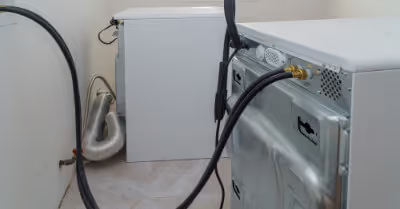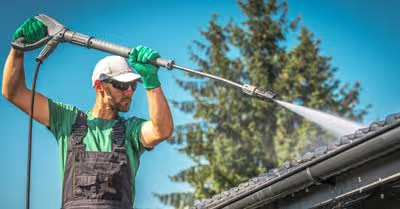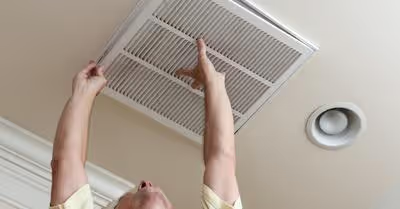Table of Contents
What Causes Thin Grass?
There are a lot of causes of thin grass. Sometimes it is a combination of things that causes the grass. There are ways to tell what the cause is so that you can fix your yard and make it green and lush again.
Compacted Soil
Pressure continually pushes down on your soil which compacts it over time. It can even be compacted quickly by heavy rain, consistent foot traffic, or heavy machinery or vehicles. Even riding lawn mowers can compact soil over time. When soil gets compacted, it does not let enough water, nutrients, and oxygen in which weakens the grass and makes it thinner. Your grass may also turn brown.
There are several ways you can tell if your soil is compacted. If there are low areas of your lawn that are gathering puddles of water or if the water is flowing away quickly from other areas, then you may have compacted soil in areas around the yard. This is common with heavy clay soil and may be hard to pierce with a shovel.
Thatch
Thatch is a layer of decomposed grass stems and roots that builds up over time. It will block the grass from growing properly and becomes a problem when it gets thicker than a half inch. A lot of things can contribute to excessive thatch buildup including over-watering at night, drought, over-fertilization, and poor soil quality.
Thatch also happens in new lawns when sod has been installed over dips and spaces or when the soil has not been prepared or watered correctly.
Poor pH
Most lawns do well in a pH range between 6 and 7, but it is best to have a pH level suited for your grass type. Check out this spreadsheet to learn more about different grass types and their best pH levels.
One indication that you may have acidic soil with a low pH is excessive thatch and weeds. Certain weeds like shepherd's purse, crabgrass, and moss are signs of acidic soil. Grass with a low pH level may develop bare patches and thin areas while the living portions remain yellow.
Pollution, dying vegetation, compost, and animal waste are all things that can affect pH. Also, overwatering or excessive rain can dilute the nutrients that the grass needs which can negatively affect pH levels. Finally, too much or incorrectly applied fertilizer can also affect the pH level because it disrupts the nutritional balance that the grass needs to properly grow.
Improper Fertilization
A lot of homeowners neglect fertilizer and over time this can have dire consequences for your lawn. Too little or too much fertilizer can cause your grass to thin out. Too much can give too much nitrogen to the soil, but you do want to make sure that your lawn has enough nutrients to grow correctly. It is a good idea to fertilize two times a year, but some lawns may need more.
Rust Disease
Rust disease can cause irregular patches in your yard and turn the grass yellow. It will also thin out the turf and spread throughout the entire lawn. It is most common with perennial ryegrass, tall fescue, kentucky bluegrass, and zoysiagrass.
Grubs
Grubs can severely damage a lawn. The damage often presents itself as dead spots, patches, or areas with thinning. If you pull back on the grass and it pulls out easily, then you likely have grubs that are eating away at the root system. You may also see white grub worms inside the soil. You will have to get rid of them before you thicken the grass.
Excessive Shade
Too much shade can contribute to thinning grass. If you have this issue, then you may want to think of using a grass that is good in the shade. Centipede grass is tolerant to shade. Fine Fescue can take some shade as well. Alternatively, you could trim back trees if that is the cause of the shade.
How to Thicken Grass
There are different things you can do to thicken grass. However, if you have a problem like grub worms or shade, you will want to fix that problem before you attempt to thicken the grass and make it healthy again.
Dethatching
A thin layer of thatch is actually good for your lawn because it can help to protect against temperature fluctuation and helps to keep in moisture. However, if the thatch gets too heavy it will block water and fertilizer and traps the roots of the grass. Thatch may start to harm your lawn when it gets to a half inch thick, but will really do damage after it reaches an inch of thickness.
You can manually remove thatch using a thatching rake. These types of rakes have blades that are designed to pull thatch away from the soil. However, they may not be good enough for heavy thatch. If your thatch is over an inch and a half thick, you may want to use a power rake. A power rake has rotating tines that will dig further down to pull the thatch up.
Vertical mowers are another option. These have vertical blades that will cut down into the soil. This is best for yards that have thick thatch that you plan on renovating with overseeding anyways. You can adjust the blades depending on how much thatch you would like to remove at a time.
Aerate
This is the best option if you have compacted soil because it will penetrate the soil so that air, water, and nutrients can reach the root system. It is best to aerate your lawn during the growing season because it will allow the grass to fill in the open areas. For warm-season grasses try to aerate during the late Spring. For cool-season grasses, early Spring or early Fall tends to be the best time.
As far as the tool used to aerate, you have two options. A spike aerator will poke holes into the ground while a plug aerator will remove a plug of grass and soil. It is a good idea to moisten the soil before you aerate. This will make it easier to penetrate or pull up the soil.
Also, try not to leave soil plugs around your yard. You may have to wait for them to dry, but then you can break them up to keep the soil even. You can even run them over with your lawn mower to spread them around and even them out.
Water Properly
For some places, you may have to water every day or two. For me, frequent watering is a necessity in the Summer because I live in a hot, dry region. However, infrequent watering can actually encourage thick growth as long as you water it deep enough.
After you water the lawn, you can check to make sure the water penetrated the soil enough to adequately reach the root system and provide the moisture your grass requires. One or two hours after watering, check the soil by pushing a screwdriver or trowel 6 to 8 inches deep. When you pull the tool out of the ground, you can check whether or not the soil is moist that deep because moist soil will cling to it. If the soil remains dry, you will have to water it more.
Fertilizer
Grass will grow thicker when you properly apply fertilizer. You should fertilize your lawn at least once a year, but some yards require two applications or more every year. If your lawn has already been thinning out and you notice it thickening from an application of fertilizer that may be a sign that you need more frequent fertilization. Also, whenever you mow the yard, leave the grass clipping because they will also fertilize the lawn.
Weed Control
Weeds can eat up sunlight, water, and nutrients that your grass needs. Eliminating weeds means eliminating the competition. It may seem like a never ending battle, but it is crucial if you want a thick, green lawn. You can apply herbicide before the weeds appear in the Spring to get ahead of the weed problem. There are some weed killers that also include fertilizer that may help get your thin lawn back into shape.
Overseeding
Overseeding is a great way to thicken a thinning lawn if the grass is still healthy. First, you have to dethatch and remove any debris. The best time to apply grass seed is during the fall. This will let your grass establish itself.
It is usually a good idea to use an aerator while you dethatch as well so that the seeds can make their way in. This increases the likelihood that they will germinate. Go along the yard twice. The second time you go over the yard, go in the direction that is perpendicular to the original rows you made.
Spread the seed using a spreader to apply it evenly. Try not to seed while it is windy because the wind can blow the seeds and make the application uneven. After you finish seeding, you should apply a fertilizer that was designed for the type of seed that you used.
Slow-release fertilizer is best because it will slowly provide the nutrients to the grass over a few months. However, you can also use quick-release fertilizer as long as you do another application 5 to 7 weeks later. As soon as you are down seeding and fertilizing you should water the yard.
Fix Soil pH
The pH of your soil can affect the nutrient absorption, but it can be hard to tell if this is the cause of your thinning grass so you may have to test it. You can hire a professional to test the soil and send it to a lab, but there are simple tests you can do at home to see if the soil is too alkaline or acidic.
To test to determine whether or not the soil is alkaline, you will need two containers and a garden trowel as well as baking soda and vinegar. Scoop soil from around the yard where it is thinning and put it into one of the containers. Add water and mix it all together. Then, put some white vinegar in. If the mixture begins to bubble or fizzle, then the soil is alkaline. If it bubbles violently then it is very alkaline.
The second test will help you determine if your soil is acidic. Add water and mix it thoroughly. Then you will add baking soda. If this sample bubbles then you have acidic soil. The more it bubbles, the more acidic your soil is. If it only slightly bubbles, then you may not need to adjust because slightly acidic soil can be good for most grasses. However, if you have a lot of bubbling, then you will need to adjust the pH level.
If you have determined that you have alkaline level soil, you will have to decrease the pH level using aluminum sulfate or sulfur. When you apply either one, you have to work it into the soil and then water the grass so that it does not stay on the leaves of grass for too long. You can use a small amount at a time and then retest the soil until the pH is normal.
If you have a low pH, then you can use pulverized agricultural limestone or lime to bring it up to normal levels. Use a spreader and then water it immediately afterwards. Again, you can do a little at a time before retesting until your soil reaches a good pH level for the type of grass that you have.
Mow Correctly
A lot of homeowners set their mowing habits to a precise schedule. Instead, you should try to mow the lawn according to the speed of growth. You should mow it enough to keep it within a good length range. You should mow off the top third of the blades each time you mow.
You also should sharpen or replace the blades on your mower regularly. Dull blades can tear and rip the grass. It is also a good idea to switch the mowing pattern every so often because going over the same exact spots can contribute to thinning grass.
Recent Articles
















